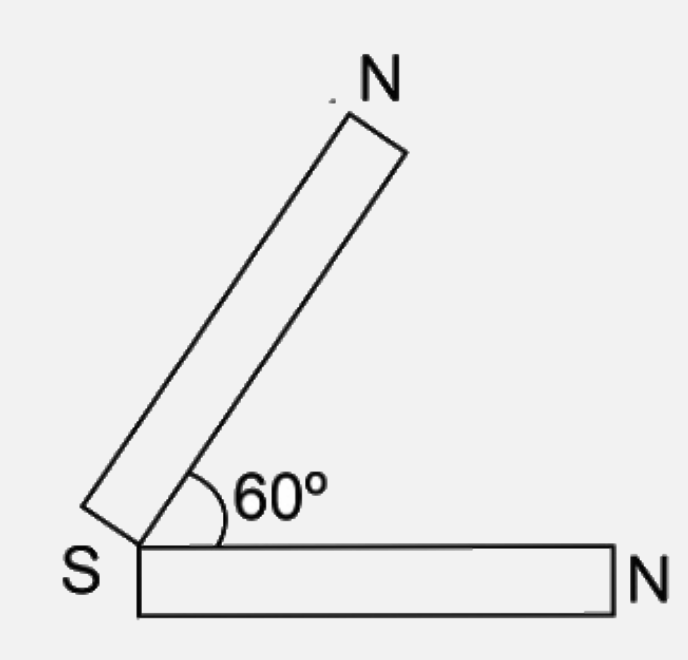Two magnets of magnetic moments M and M√3 are joined to form a cross(+) . The combination is suspended freely in a uniform magnetic field . At equilibrium position, the magnet of magnetic moment M makes an angle theta with the field, then theta is
60°
30°
90°
45°
To solve the problem, we need to analyze the situation involving two magnets with magnetic moments M and M√3 that are joined to form a cross (+) shape. The combination is suspended in a uniform magnetic field, and we need to find the angle θ that the magnet with magnetic moment M makes with the magnetic field at equilibrium.
1. Understanding Magnetic Moments:
- We have two magnets with magnetic moments M and M√3. The magnetic moment is a measure of the strength and orientation of a magnet.
2. Magnetic Field Due to Each Magnet:
- The magnetic field B produced by a magnetic moment m is proportional to the magnetic moment. Thus, we can denote:
- The magnetic field due to the magnet with moment M as F.
- The magnetic field due to the magnet with moment M√3 as √3F.
3. Vector Addition of Magnetic Fields:
- Since the magnets are arranged in a cross shape, the total magnetic field Bnet at the point of suspension will be the vector sum of the two fields:
Bnet=F+√3F
- This simplifies to:
Bnet=(1+√3)F
4. Finding the Angle θ:
- The angle θ that the magnet with moment M makes with the magnetic field can be determined using the geometry of the situation. The two magnetic fields F and √3F form a triangle.
- The angle between the two fields is 30∘ because the tangent of the angle formed by the two vectors can be expressed as:
tan(30∘)=F√3F=1√3
- Therefore, the angle θ that the magnet with moment M makes with the external magnetic field is 30∘.
5. Conclusion:
- Thus, the angle θ is:
θ=30∘
Final Answer:
The angle θ is 30∘.
- We have two magnets with magnetic moments M and M√3. The magnetic moment is a measure of the strength and orientation of a magnet.
- The magnetic field B produced by a magnetic moment m is proportional to the magnetic moment. Thus, we can denote:
- The magnetic field due to the magnet with moment M as F.
- The magnetic field due to the magnet with moment M√3 as √3F.
- Since the magnets are arranged in a cross shape, the total magnetic field Bnet at the point of suspension will be the vector sum of the two fields:
Bnet=F+√3F
- This simplifies to:
Bnet=(1+√3)F
- The angle θ that the magnet with moment M makes with the magnetic field can be determined using the geometry of the situation. The two magnetic fields F and √3F form a triangle.
- The angle between the two fields is 30∘ because the tangent of the angle formed by the two vectors can be expressed as:
tan(30∘)=F√3F=1√3
- Therefore, the angle θ that the magnet with moment M makes with the external magnetic field is 30∘.
- Thus, the angle θ is:
θ=30∘
The angle θ is 30∘.
Similar Questions
Two magnets of magnetic moments 4Am2and3Am2 are joined to form a cross (+), then the magnetic moment of the combination is
View SolutionA charged particle enters a uniform magnetic field perpendicular to it. The magnetic field
View SolutionIf a bar magnet moment M is freely suspended in a uniform magnetic field of strength field of strength B, then the work done in rotating the magent through an angle θ is
View SolutionA bar magnet of magnetic moment M is bent in the form of quadrant of circular arc . The new magnetic moment is
View SolutionThe net magnetic moment of the two identical magnets each of magnetic moment M0 inclined at 60∘ with each other is

View SolutionTwo magnets, each of magnetic miment 'M' are placed so as to form a cross at right angles to each other. The magnetic moment of the system will be
View SolutionA current carrying circular coil, suspended freely in a uniform external magnetic field orients to a position of stable equilibrium. In this state :
View SolutionAs loop of magnetic moment M is placed in the orientation of unstable equilbirum position in a uniform magnetic field B. The external work done in rotating it through an angle θ is
View SolutionAs loop of magnetic moment M is placed in the orientation of unstable equilbirum position in a uniform magnetic field B. The external work done in rotating it through an angle θ is
View SolutionThe rate of change of torque 'τ' with deflection θ is maximum for a magnet suspended freely in a uniform magnetic field of induction B when θ is equal to
View Solution
